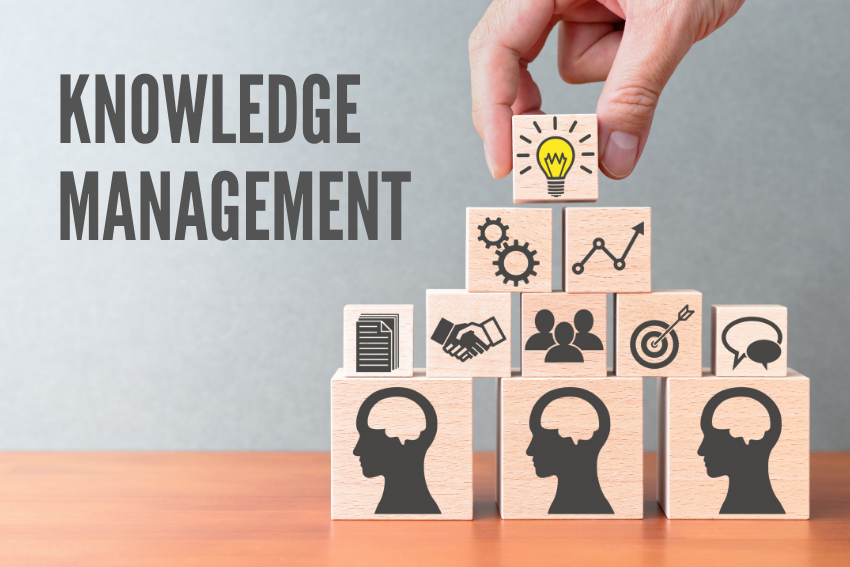With the current dynamic business world, many companies have started to appreciate the value of their intangible capital. The economy is believed to be operating with knowledge as its principal asset, and this is viewed as a well-recognized key factor in sustaining competitiveness. But what specifically is knowledge management, and how can businesses harness it for success?
The Role of Knowledge Management

Knowledge management can therefore be described as the use of various processes and techniques in managing the exchange and utilization of information and knowledge. It comprises the approaches of acquiring, acquiring, and sharing the know-how of employees, consumers, and stakeholders to boost organizational effectiveness, imagination, and sustainability.
Fundamentally, KM’s role revolves around making sure that any given information or knowledge is in the correct place at the correct time to improve on decision-making, solution-finding, and creativity. Strategic communication is all about utilizing the knowledge of an organization and applying this to achieve a desired goal, namely development and sustainability.
The Evolution of Knowledge Management
Knowledge management has therefore developed from the time it began in the mid-1980s and early 1990s. To begin with, knowledge management was more of a technical fix that more or less raised simple objectives of collecting and storing knowledge in databases or intranets. But as organizations began to discover the drawbacks of this approach, it progressed into a more encompassing approach that factors in people, processes, and culture as well.
Nowadays, the process of knowledge management is acknowledged as a subject-matter field that is associated with multiple other domains: information science, organizational behavior, business strategy, and others. KM in the contemporary world has been seen to focus on the establishment of rules that fast-track the sharing of knowledge, promote cooperation, and integrate KM projects with organizational objectives.
Types of Knowledge in Organizations
However, a brief discussion on the nature of knowledge that exists within organizations will be essential before looking at the various subcategories in knowledge management.
Explicit Knowledge: This is formal, codified knowledge that can be easily documented, stored, shared, or transmitted to those within the organization who have a need to know. Examples include written institutions, books, records, procedures, handbooks, reports, and data banks. Tacit knowledge, being the second type, is also relatively easy to deploy by traditional concepts of knowledge management.
Tacit Knowledge: This is therefore non-professional, individualistic knowledge held in the human person’s informal memory system. Sometimes it is hard to explain and document because it incorporates experience, judgment, and perceptions developed over years of practice. General management of tacit knowledge is somewhat more difficult, but at the same time, it might be even more effective, as this type of knowledge often underlies considerable potential for innovation and competitive advantage.
The knowledge that can be shared across an organization is categorized as non-tacit or informational, and this is the type of knowledge for which there are already mechanisms for storage and retrieval in organizations today.
Types of Knowledge Management
The system of KMS relates to various methods and plans that are targeted at the specific organizational requirements and certain types of knowledge. Here are the main types of knowledge management:
1. Knowledge Creation and Acquisition
In this type of KM, the aim is to create new knowledge within or outside of the organization or to purchase this knowledge. Strategies include:
- The research and development strategies.
- While developing a strategic reference model for their universities, participants were asked to work in groups and develop collaborative projects and partnerships.
- Sprat and skill-building initiatives.
- Such policies involve the employment of experts and consultants.
- Acquisitions as a source of acquiring industry-specific knowledge and expertise.
The acquisition of knowledge and its creation are very critical for competitiveness and innovation. The organizations that are usually excellent in this area are usually the market standards and opinion leaders.
2. Knowledge Storage and Organization
It is a kind of KM that focuses on a systematic process whereby acquired knowledge is codified, archived, and indexed in such a way that others can easily find it. Key components include:
- Document management systems.
- Knowledge bases and wikis.
- Intranet and company portal.
- Taxonomies are classified data systems or segment archives that are hierarchically organized to provide structure to an array of topics, as are metadata, which are small data items used for document categorization.
- Version control and archiving.
Meaningful knowledge management allows for the capture and proper indexing of information so that this is not wasted and can be retrieved easily at the right time, enhancing efficiency and quality of decision-making.
3. Knowledge Sharing and Distribution
This aspect of KM is all about enabling the sharing of that knowledge across an organization. Strategies include:
- Networking sites and interactive tools.
- Communities of practice.
- The existence of structured courses in mentoring and coaching.
- Knowledge-sharing events and workshops.
- All internal newsletters and communication means.
Sharing of knowledge ensures that the organization reduces barriers that are brought about by the employment of different specialists, stimulates creative thinking, and guarantees that the best practices are spread all around the departments in an organization.
4. Knowledge Application and Utilization
This type of KM focuses on knowledge application as a way of improving the operations of an organization. It involves:
- Decision support systems.
- Best practice databases.
- Use of knowledge resources in the course of work.
- Performance support tools.
- Products and services that contain knowledge.
The objective of KM is to put knowledge to strategic use so that it can produce desired organizational performance, increase customer satisfaction, and foster creation.
5. Knowledge Retention and Preservation
An integrated model of job design for knowledge-intensive organizations Knowledge Retention and Preservation
This KM type aims at holding information that may otherwise disappear with an employee, retire, or as a result of changes in the organization. Strategies include:
- Succession planning
- End-of-the-term interviews and storage of organizational knowledge seminars.
- Records of important activities and know-how.
- Both expert systems and knowledge bases.
- The second category is knowledge transfer-based programs, which can be described as the practice of pairing the young generation of workers with well-experienced mentors so as to implement an established practice.
Knowledge retention is essential in organizations because it helps to uphold organizational memory and consequently continuity.
Use Cases for Knowledge Management
KM can easily be implemented in any business function and in any organization, irrespective of the industry it belongs to. Here are some common use cases that demonstrate the versatility and value of KM:
Customer Service and Support
KM plays a crucial role in improving customer service by:
- Making customer service representatives easily available with product information and most frequently asked questions, among other relevant details.
- Offering the customers the ability for self-service using knowledge bases and community forums.
- Allowing the support teams to share the best practices with other teams.
- Differentiating between the various ways customers engage and respond to an organization’s service delivery and the ensuing analysis in search of trends.
- Using KM therefore can improve such aspects as customer satisfaction, response time, and first-call resolutions.
To conclude, two broad strategic categories can be outlined: product development and innovation.
Product Development and Innovation
- Collecting and disseminating information that analyzes feedback from markets and consumers.
- Enabling cross-functional teams’ work.
- Keeping records of previous activities, achievements, and previous projects with a record of unsuccessful results achieved.
- To allow the fast creation of prototypes and automatic adaptations, which rely on the aggregate amount of information.
It has also been clearly established that when knowledge is well managed in product development processes in any organization, then new products can be taken to the market with efficiency and gain high market acceptance.
Employee Onboarding and Training
KM can streamline employee onboarding and ongoing training by:
- Giving new employees an option to find information regarding specific policies or procedures and learn from the best practices of other employees.
- Providing access to literature and course-specific e-learning tools.
- Supporting the possibilities to share experiences, especially between young and experienced colleagues.
- It is then possible to capture and transfer different kinds of know-how more specifically: first, telling and retelling personal sagas or frozen stories; and second, using cases as more structured carriers of specific types of organizational learning.
Best practices in KM practice in the context of training and onboarding generate higher rates of first-year performer productivity, higher levels of training satisfaction, and ultimately higher retention levels.
Project Management
KM can enhance project management practices by:
- Setting up a project documentation reference library or knowledge management system capturing lessons learned and best practices
- Enabling information exchange between the working projects’ teams and other interested parties
- In enabling this, historical project data will be made accessible for better risk management.
- Enhancing the distribution of resources in accordance with the existing and established skills and experience.
When KM is included in project management, it is easy to avoid repeating the previous mistakes, and hence there is an improvement in the rates of success of an organization in its projects.
Sales and Marketing
KM can boost sales and marketing effectiveness by:
- Updating the sales force with information about products, competitors, and customers
- Enabling original and innovative strategies and techniques to be adopted by successful salespeople
- Customer knowledge management so that personalization to the target markets could be efficiently achieved through marketing.
- Assistance in the creation of content related to marketing and in managing content for marketing campaigns
Application of KM in sales and marketing results in an increased conversion ratio, increased customer interaction, and better targeting of marketing.
Research and Development
KM is crucial in R&D environments, helping organizations:
- It’s important to keep a detailed record of your research and results, as well as all the experimental data.
- The purpose is to enhance the communication between researchers from different places and fields.
- Safeguard intellectual assets by documenting them and taking all the necessary steps to protect knowledge assets.
- Promote the transfer of technology and improved research results to the market.
Overall, organizations that properly leverage knowledge as an input in R&D can enhance organizational innovation, enhance patent protection, and guarantee market competitiveness in the field of operation.
Challenges in Knowledge Management
Despite the enormous returns that accrue from knowledge management, establishing and maintaining knowledge management programs presents some challenges to organizations. Common obstacles include:
System 1 can be characterized by resistance to change and poor knowledge sharing.
While seeking knowledge, there is information abundance, and it is not easy to find the right information.
Due to these a number of challenges, this has remained one of the major challenges affecting the success of KM activities, namely, insufficient time for KM activities.
Another challenge of implementing the knowledge management strategy is the fact that much of the knowledge is tacit.
Sustaining authority and currency of knowledge within knowledge assets
One of the questions often asked on KM initiatives is how to measure the return on investment of such strategies.
In order to overcome these challenges, it is necessary to foster strategic planning at different levels, cultural changes, and technological solutions. Before implementing KM, the organizations need to be ready to carry out changes in the approaches based on feedback and results.
The Future of Knowledge Management
As we look to the future, several trends are shaping the evolution of knowledge management:
information theory, and other fields.
AI and ML technologies are revolutionizing KM by:
- Reducing knowledge acquisition and management to an IT activity
- offering the importance of smart searching and recommending functions
- Inference-making on large datasets in order to arrive at an understanding of content and trends.
- Supporting more convenient information identification and acquisition utilizing natural language
- The specific technologies for KM claim that the process is becoming more efficient, personalized, and proactive.
The integration of the company with other emerging technologies
KM is increasingly being integrated with other emerging technologies, such as:
- Knowledge enhancement in the internal training process using blended learning technologies
- Blockchain for the protection and confidentiality for the exchange of knowledge.
- Use of “Internet of Things (IoT)” in order to capture and apply knowledge in a real-time mode
- Using the 5G networks for unblocking the knowledge resources.
- Such integrations are in the process of expanding new opportunities in a systematization and practical usage of knowledge by organizations.
Focus on Knowledge Ecosystems
The future of KM extends beyond organizational boundaries, emphasizing:
- The involvement of external stakeholders, particularly customers and suppliers
- Technology-based open service platforms and K workers and knowledge markets
- Intersectoral model of exchange and adaptation of the best practice activities
Virtual and Communities of Practice
This ecosystem approach acknowledges the fact that a lot of good knowledge exists outside the formal organizational structures.
- A targeted and environment-specific knowledge acquisition
- Future KM systems will focus on delivering the right knowledge to the right person at the right time by:
- Using AI in learning user needs and its peculiarities
- Offering information with reference to the situation
- Initiating and integrating KM technologies into various processes and decision-making seamlessly.
- Sustaining personalized learning and development options
- This approach is particularly applied to make the KM as relevant and valuable as possible to a specific user.
Conclusion
Knowledge management has gone from being an IT-directed initiative to one that includes the people, the processes, and the culture. Consequently, the importance of KM only grows stronger as organizations struggle to maintain competitiveness in the current global knowledge-based economy.
Having examined the different forms of knowledge management, the specific KM application of other forms, and the selected strategic KM approaches, the proposition is that organizations can enable the optimal effective exploitation of organizational and employee knowledge and experience. That is why, despite the difficulties that are inevitable while attempting to implement KM, the advantages that can bring efficient implementation are apparent—better decision-making, an innovative boost, and increased efficiency.
For the future, growth in new concepts and trends in the technological practices guarantees to increase the effectiveness of knowledge management as well as its applicability in organizations. Therefore, awareness of these trends, and in particular the willingness of organizations to modify their KM practices to reflect these findings, represents a key to continued effectiveness in the utilization of knowledge and the generation of new knowledge in business and other fields.
Finally, therefore, knowledge management is not about managing information; it is about the process of learning, sharing, and creativity.
Organizations that embrace this holistic view of KM will be well-positioned to thrive in an increasingly complex and competitive business landscape.






